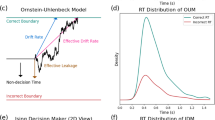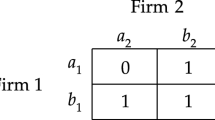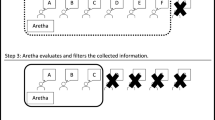Abstract
Classical models of decision making deal fairly well with uncertainty, where settings are well-structured in terms of goals, alternatives, and consequences. Conversely, the typical ill-structured nature of strategy choices remains a challenge for extant models. Such cases can hardly build on the past, and their novelty makes the prediction of consequences a very difficult and poorly robust task. The weakness of the classical expected utility model in representing such problems has not been adequately solved by recent extensions. In this paper we offer an explanatory coherence model for decision making in ill-structured problems. We model alternatives as sets of concurrent causal explanations of reality that act as justifications for action. According to these premises, choice is based on an evaluation of the internal coherence and the consistency of competing explanations of the available evidence. This model is psychologically grounded on causal inference and builds on the connectionist tradition of explanatory coherence. To illustrate the model, we consider the decision of investing in a new technology and we discuss how changes in the structure of alternatives may impact on the solution. We show how the final choice depends on collecting the relevant evidence, making the suitable hypotheses, and drawing the consistent causal explanations linking the two.




Similar content being viewed by others
Notes
This example is freely built on the well-known statements made in 1977 at the Convention of the World Future Society by Kenneth Olsen, co-founder of Digital Equipment Corporation, and his later hindsight of his decisions not to invest in personal computers. Sources are: an interview with Kenneth Olsen by David Allison made on September 28–29, 1988, Division of Information Technology and Society, National Museum of American History, Smithsonian Institution, available at http://americanhistory.si.edu/collections/comphist/olsen.html#tc21, last visited February 05, 2014; Anderson (1984)
About 30 years later we can clearly see that that decision was wrong. The PC has been a success and the market has grown at surprising pace. However, decision at that time was ill-structured and choice took the form of a claim and a justifying argument rather than of a calculation including estimates of risk and uncertainty.
Note that CBDT is also suitable for modeling routine decisions, i.e. repeated well-structured problems whose solution has been memorized and is applied each time without processing the decision. Thus also in those cases when decision becomes rule-based, CBDT is a good model of decision.
Our model refers to coherent theories of epistemic justification, usually formulated as an alternative to foundationalist views of epistemology (Gardenfors, 1990). Both coherentism and foundationalism try to answer the fundamental problem of epistemology, the regress argument that goes as follows: given some statement P, it is reasonable to ask for a justification for P, which is justified by another statement P’, and so forth. Fundamentalists conclude that there is a set of statements that is self-evident and do not need further justification. All other chains of justification are based on them. For instance, Decartes’ ‘I think therefore I am’ is the most famous example of a self-evident statement which supports the whole body of knowledge. Similarly, empiricists take observations as foundation of knowledge.
On the other hand, coherentists deny the validity of the regression argument taking the form: P’’ justifies P’ which justifies P etc. They consider justification a holistic process and not a chain of reasoning. P is justified because it coheres with some system of thoughts. With much less concern on the issue of truth in comparison with fundamentalists, coherentists usually identify the system with the complete set of beliefs of the individual or of a group or of a society. Within this paradigm, in our model explanations are required to be internally coherent.
Nevertheless, our model is constructed as a so-called “discriminating coherence” model (Thagard and Verbeurgt 1998: 16) in which elements resulting from observation or experiments are given priority. The algorithm spreads activation first to these elements that should be favored in the coherence calculation. In such way, we can have some confidence that the most coherent explanations “also correspond to the world and are not mere mind-contrivances that are only internally coherent” (Thagard and Verbeurgt 1998: 17).
This case builds on extensive evidence collected by the authors both in terms of second-hand materials and via interviews with direct informants, experts in the telecommunication industry.
References
Anderson JJ (1984) Dave tells Ahl the history of Creative Computing. Creat Comput 10(11):66
Axelrod R (1984) The evolution of cooperation. Basic Books, New York
Cyert RM, March JG (1963) A behavioral theory of the firm. Prentice-Hall, Englewood Cliffs, NJ
Duff I (2002) Profile of Telecom Italia S.p.A. (Telecom Italia). Institute for Japanese–European Technology Studies, University of Edinburgh. http://www.telecomvisions.com/articles/pdf/telecom_italia_profile.pdf. Accessed 15 Jan 2012
Eliasmith C, Thagard P (1997) Waves, particles, and explanatory coherence. Br J Philos Sci 48:1–19
Frigotto ML, Rossi A (2012) Diversity and communication in teams: improving problem-solving or creating confusion? Group Decis Negot 21(6):791–820
Gardenfors P (1990) The dynamics of belief systems: foundations vs. coherence theories. Revue Internationale de Philosophie 44:24–46
Gavetti G, Levinthal DA, Rivkin JW (2005) Strategy making in novel and complex worlds: the power of analogy. Strateg Manag J 26:691–712
Gilboa I, Schmeidler D (1995) Case-based decision theory. Q J Econ 110:605–639
Hayes JR, Simon HA (1974) Understanding written problem instructions. In: Gregg LW (ed) Knowledge and cognition. Potomac, Lawrence Eribaum Associates
Hong L, Page SE (2001) Problem solving by heterogeneous agents. J Econ Theory 97:123–163
Hong L, Page SE (2004) Groups of diverse problem solvers can outperform groups of high-ability problem solvers. PNAS 101:16385–16389
Hopfield JJ (1982) Neural networks and physical systems with emergent collective computational abilities. Proc Natl Acad Sci USA 79:2554–2558
Hutchins E (1995) Cognition in the wild. MIT Press, Cambridge
Kahneman D (2002) Maps of bounded rationality: a perspective on intuitive judgment and choice. Nobel Prize Lect, December 8, also in Am Econ Rev (2003) 93:1449–1475
Keil FC (2006) Explanation and understanding. Annu Rev Psychol 57:227–254
Lindgren M, Bandhold H (2003) Scenario planning: the link between future and strategy. Palgrave Macmillan, New York
Mannix EA, Neale MA (2005) What differences make a difference? Psychol Public Interes 6(2):31–55
March JG, Olsen J (1986) Garbage can models of decision making in organizations. In: March J, Weissinger-Baylon R (eds) Ambiguity and command. Organizational perspectives on military decision making. Pitman Publishing, Marshfield
March JG, Simon HA (1958) Organizations. Wiley, New York
March JG, Sproull LS, Tamuz M (1991) Learning from samples of one or fewer. Organ Sci 2(1):1–13
Marchiori D, Warglien M (2005) Constructing shared interpretations in a team of intelligent agents: the effects of communication intensity and structure. In: Terano T, Kita H, Kaneda T, Arai K, Deguchi H (eds) Agent-based simulation: from modeling methodologies to real-world applications. Post-proceedings of the third international workshop on agent-based approaches in economic and social complex systems 2004. Springer, Berlin, pp 58–71
Millgram E, Thagard P (1996) Deliberative coherence. Synthese 108:63–88
Newell A, Shaw JC, Simon HA (1958) The process of creative thinking. The RAND Corporation, Santa Monica
Nowak G, Thagard P (1992a) Copernicus, Ptolemy, and explanatory coherence. In: Giere R (ed) Cognitive models of science, vol 15. University of Minnesota Press, Minneapolis, pp 274–309
Nowak G, Thagard P (1992b) Newton, Descartes, and explanatory coherence. In: Duschl RH, Hamilton RJ (eds) Philosophy of science, cognitive psychology and educational theory and practice. SUNY, Albany, pp 69–115
Pennington N, Hastie R (1986) Reasoning in explanation-based decision making. Cognition 49:123–163
Ranney M, Schank P (1995) Protocol modeling, bifurcation/bootstrapping, and convince me: computer-based methods for studying beliefs and their revision. Behav Res Methods Instrum Comput 27:239–243
Ranney M, Schank P (1998) Toward an integration of the social and the scientific: observing, modeling, and promoting the explanatory coherence of reasoning. In: Read S, Miller L (eds) Connectionist models of social reasoning and social behaviour. Erlbaum, Mahwah, pp 245–274
Read SJ, Marcus-Newhall A (1993) Explanatory coherence in social explanations: a parallel distributed processing account. J Pers Soc Psychol 65:429–447
Ringland G (2006) Scenario planning: managing for the future, 2nd edn. Wiley, Chichester
Rubinstein A (1998) Modeling bounded rationality. MIT Press, Cambridge
Rumelhart DE, Smolensky P, McClelland JL, Hinton GE (1986) Schemata and sequential thought processes in PDP models. In: Rumelhart DE, McClelland JL, the PDP Research Group (eds) Parallel distributed processing: explorations in the microstructure of cognition, vol 2. MIT Press, Cambridge, pp 45–76
Savage LJ (1954) The foundations of statistics. Wiley, New York
Schank P, Ranney M (1991) The psychological fidelity of ECHO: modeling an experimental study of explanatory coherence. In: Proceedings of the 13th annual conference of the cognitive science society. Erlbaum, Hillsdale, pp 892–897
Schank P, Ranney M (1992) Assessing explanatory coherence: a new method for integrating verbal data with models of on-line belief revision. In: Proceedings of the 14th annual conference of the cognitive science society. Erlbaum, Hillsdale, pp 599–604
Schank P, Ranney M (1993) Can reasoning be taught? Educator 7(1):16–21
Seidl D (2004) The concept of weak signals revisited: a re-description from a constructivist perspective. In: Tsoukas H, Shepherd J (eds) Managing the future: foresight in the knowledge economy. Blackwell, Oxford, pp 151–168
Simon HA (1973) The structure of ill-structured problems. Artif Intell 4:181–201
Simon HA (1991) Bounded rationality and organizational learning. Organ Sci 2:125–134
Spellman BA, Ullman JB, Holyoak KJ (1993) A coherence model of cognitive consistency: dynamics of attitude change during the Persian Gulf War. J Soc Issues 49(4):147–165
Thagard P (1989) Explanatory coherence. Behav Brain Sci 12:435–467
Thagard P (1992a) Adversarial problem solving: modeling an opponent using explanatory coherence. Cogn Sci 16:123–149
Thagard P (1992b) Conceptual revolutions. Princeton University Press, Princeton
Thagard P (1998a) Ulcers and bacteria I: discovery and acceptance. Stud Hist Philos Sci Part C: Stud Hist Philos Biol Biomed Sci 29:107–136
Thagard P (1998b) Explaining disease: correlations, causes, and mechanisms. Minds Mach 8:61–78
Thagard P (2000a) Probabilistic networks and explanatory coherence. Cogn Sci Q 1:91–114
Thagard P (2000b) Coherence in thought and action. MIT Press, Cambridge
Thagard P (2004) Causal inference in legal decision making: explanatory coherence vs. bayesian networks. Appl Artif Intell 18:231–249
Thagard P, Millgram E (1997) Inference to the best plan: a coherence theory of decision. In: Ram A, Leake DB (eds) Goal-driven learning. MIT Press, Cambridge, pp 439–454
Thagard P, Verbeurgt K (1998) Coherence as constraint satisfaction. Cogn Sci 22(1):1–24
Ungson GR, Braunstein DN, Hall PH (1981) Managerial information processing: a research review. Adm Sci Q 26(1):116–134
Wang H, Johnson TR, Zhang J (2006) The order effect in human abductive reasoning: an empirical and computational study. J Exp Theor Artif Intell 18(2):215–247
Weick KE (1979) The social psychology of organizing. Addison-Wesley, Reading
Weick KE (1995) Sensemaking in organzations. Sage, Thousand Oaks
Williams KY, O’Reilly CA (1998) Demography and diversity in organizations: a review of 40 years of research. Res Organ Behav 20:77–140
Acknowledgments
We gratefully acknowledge the comments received on earlier versions of this paper from Nicolao Bonini, Guido Fioretti, Mimmo Iannelli, Alessandro Narduzzo, Paul Thagard, Massimo Warglien, Enrico Zaninotto, and the participants of seminars held at the Faculty of Science and at the Faculty of Economics at the University of Trento. We also would wish to thank the editorial board of the journal for the engaging conversation they stimulated through the selection of reviewers. In reconstructing the innovation case study, we benefited from the expertise and advice of Sandro Dionisi, Laura Riganti, Roberto Parodi e Leopoldo Tranquilli. The usual disclaimer applies. One of the authors was supported by the Professor Claudio Demattè Memorial Grant during this research.
Author information
Authors and Affiliations
Corresponding author
Rights and permissions
About this article
Cite this article
Frigotto, M.L., Rossi, A. An explanatory coherence model of decision making in ill-structured problems. Mind Soc 14, 35–55 (2015). https://doi.org/10.1007/s11299-014-0158-4
Received:
Accepted:
Published:
Issue Date:
DOI: https://doi.org/10.1007/s11299-014-0158-4




